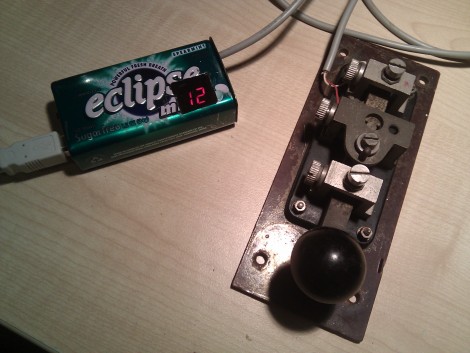
Looking for motivation to practice morse code [BenB] built this morse code keyboard. It uses USB and is recognized as a standard keyboard thanks to the V-USB stack running on the ATmega168. The project is rounded out with a clean look thanks to the chewing gum container that serves as an enclosure.
His design is simple enough that any morse key you have on hand can be used. You could even adapt that glove coder you built a couple of years back.
















Cool, 19th century meets 21st! And this could be useful, imagine a laptop with 1 touchpad, buttons and no keyboard! The only question left is what is Alt-F3 in morse code?
It’s .- .-.. – ..-. …–
Not to be a troll, but really very few people use a straight key any more. Any real morse code use is done with an iambic key (http://en.wikipedia.org/wiki/Iambic_keyer) or “paddle”. It would be nice if this design could accept a paddle as well as a straight key.
@Hirudinea
.- .-.. – ..-. …–
@Josh-
On the basis of what statistics do you make *that* claim?
considering it looks to be a open/closed circuit (single loop) setup, anything that will close the circuit will work.
On the basis of I’ve never seen any hams using a straight key outside of special vintage contests. Paddle support would just be nice, that’s all.
hey every once in a while i get board and play around with a old straight key, but josh is right, they are very rarely used anymore
yea, but a key is just a spring loaded switch, what is different to support? you want a paddle, plug it in
@Josh @Joel
I think you guys need to widen your circle of friends. I don’t know anyone who does Morse who doesn’t use a straight key. ;)
I’d agree that paddle support might be nice, however. I can’t envision that being too difficult to add.
Owh :(
I was hoping this would be a quick job to just port to an attiny45 and I’d be away, looks like its gonna be a bit more involved than that.
Ah well, best get back to revision then
@Osgeld
Iambic keys have two sets of contacts, a straight key has only one.
For a bunch of Hams, Yall sure want everything done for you. Now when I was a kid I had to dig up the galenium crystal from my backyard just to make my receiver!
If you want a paddle, add a paddle! Are you a HAM or are you an appliance user?
mints
@joecoder
You beat me to the punch. HAM Radio operaters were some of the original ‘hackers’, what happened to building your own rig and antenna with scavenged material? If a HAM wants to use a paddle with this idea, then figure the interface out. ‘Nuff said!
Sadly most of the younger hams such as myself tend to be appliance operators. But that’s something I am trying to change.
@el1m1nate
yes, mints…
I have a bunch of these mint containers waiting for a project to jam inside them.
anybody have any ideas how to “un emboss” these mint tins?
-.-. — — .-..
Cool, wish I had one.
Is there some software you can run PC side and connect to some pre-existing HID hardware?
I know USB Mice and Joysticks are $1-5 at the second-hand store and I have a bunch laying about the place.
Here are some software soundcard Morse decoders.
http://www.dxzone.com/catalog/Software/Morse_Code_Decoders/
Just in case you want to play with Morse and have zero monies.
Even better is complete computer control for the disabled using only Morse code!
http://www.makoa.org/jlubin/morsecode.htm
Seems neat, has a lot of different physical interface methods.
I love all the ideas Hackaday gets into my head, I always wanted to learn morse, now a great excuse is total computer control. Could also make a great door lock.
@Josh. The “spirit” of of this project was sending practice for someone beginning to learn Morse Code, where use of a straight key is the norm. Unless one has a rig with an internal keyer, additional circuitry is need between the paddles and the rig, paddles alone don’t make iambic keying possible. Meaning that a good number of those who use iambic keying presently can already connect to this project as it is. Respectfully something tells me you are totally unfamiliar with the subject.
An interesting take as to how to practice sending Morse, using something that most using tasks that most use a lot everyday. The only thing lacking is the immediate feedback that actual Morse contacts can provide, but every little bit of practice will help. Particularly in light that computers aren’t yet very tolerant of sloppy sending, the feed back may very well be immediate. Why isn’t any text being entered? :) Has been quite some time since I tried out PC based code reading software, so newer software may be better than the software I recall? HaD can’t post too much amateur radio hacks or projects INMO.
73 **LKK
I know hundreds of hams that use straight keys. I’ve used one for over 20 years.